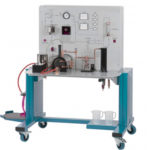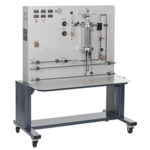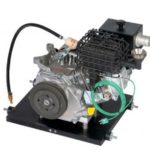Model No- AE0237
In a steam power plant, thermal energy is converted into mechanical energy, and ultimately into electrical energy. A steam power plant consists of a heat source for generating steam, a turbine or steam engine with generator, and a cooling device for condensing. The steam engine is used to convert thermal energy into mechanical energy.
The steam engine, together with the brake unit as a consumer of the electrical energy and the steam generator, forms a complete steam power plant. The trainer includes a steam engine, a condenser and a condensate tank, and comprehensive instrumentation.
Learning Objectives/Experiments
Determining the amount of steam generated, the mechanical power and the power consumption
Calculating the overall efficiency
Determining the heat dissipated in the condenser
Recording the vapour pressure curve
Effective output
Specific steam consumption by the steam engine
Thermal capacity of the boiler
Features
Functioning of a two-cylinder piston steam engine
Energy balance of the steam power plant
Design of a complete steam power plant together with steam generator and universal drive and brake unit
Specification
Two-cylinder piston steam engine
Atmospheric capacitor
Condensate tank as cascade tank with condensate pump
Steam engine loaded via brake unit
Sensor and display for temperature, pressure, flow rate, and speed
Determination of amount of steam via condensate
Steam supplied by steam generator
Technical Data
Two-cylinder piston steam engine
speed: max. 1000min-1
max. continuous power: 420W
2 cylinders
bore: 50mm
stroke: 40mm
Condensate pump
power consumption: max. 60W
max. flow rate: 2,9m3/h
max. head: 4m
Condenser
transfer surface: 3800cm2
Measuring ranges
temperature: 7x 0…400°C
pressure: 0…10bar / 0…1,6bar
speed: 0…1200min-1
flow rate: 100…1000L/h (cooling water)
230V, 50Hz, 1 phase
230V, 60Hz, 1 phase; 120V, 60Hz, 1 phase







